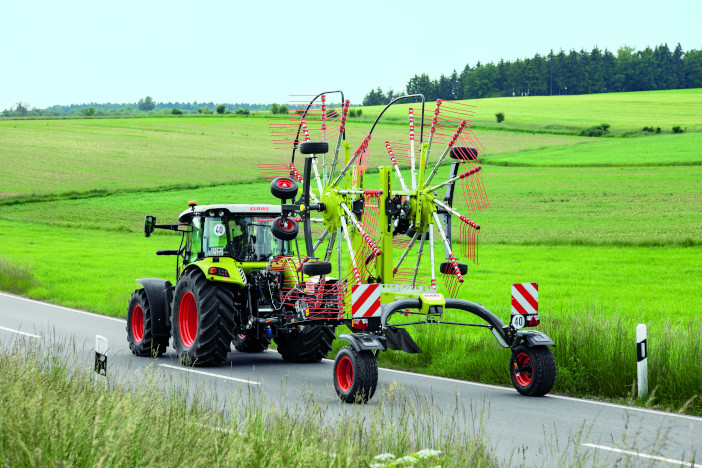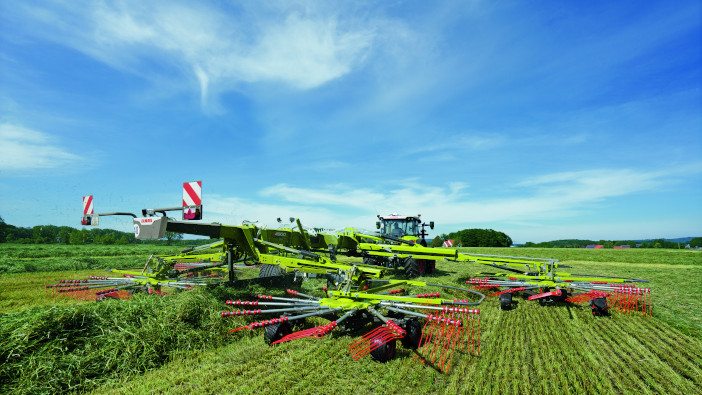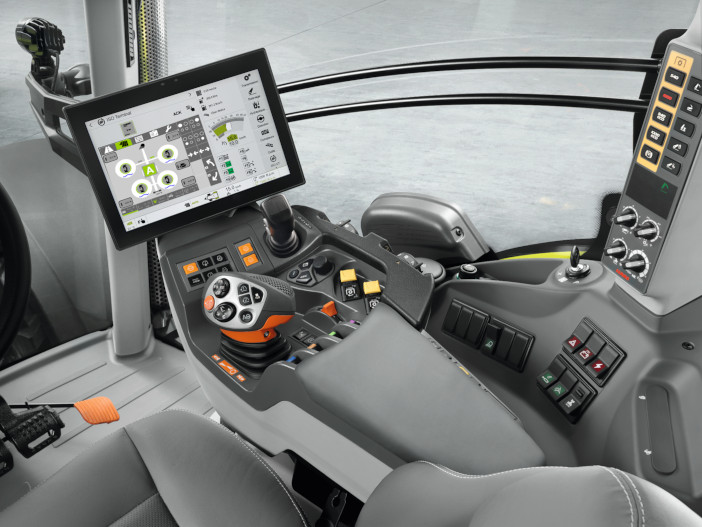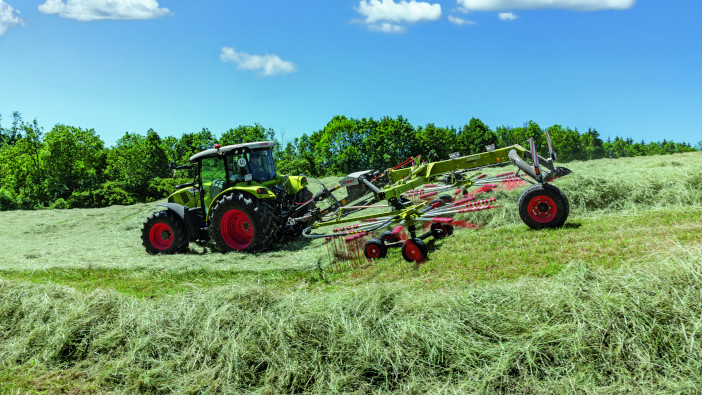A series of updates have been announced for the Claas Liner range of twin and four-rotor rakes. The latest twin-rotor series comprises five Trend models with simplified controls and two Business models which feature the Active Float suspension system.
Each model features the Grass Care rotor guidance system, actively suspending the rotors during operation so that when they are lowered into work, the rear tines touch down first to prevent the front tines from digging into the soil. Business models are further equipped with individual rotor lift through the in-cab terminal, which can be optionally added to Trend models.
The entry-level Liner 2600 and 2700 machines are fitted with a four-wheel chassis as standard, while the rest of the range comes mounted on a six-wheel chassis. In all cases, the wheels are positioned close to the circle of rotation to ensure ground-following. The front two chassis wheels are steerable and, in the case of the six-wheel chassis, the rear rotor wheels are replaced with a pendulum axle.
Floating cardan suspension ensures excellent ground following and three-dimensional rotational movement. On the rotor’s central shaft, the rake height can be easily seen and quickly adjusted using a crank handle. Hydraulic rotor height adjustment can also be specified.
On Business models, the height of each rotor can be independently adjusted using the Cemis 10 control unit and then actuating the spool valve. Direct spool adjustment of the rotor height can also be optioned on the Trend machines.
Tine arms are firmly attached by a 20-spline shaft and secured with a Profix bracket. In the event of a collision, the tine arms deflect at a predefined bending point to avoid damaging the gearbox. Dual tines with windings are fitted on the tine arm and secured with a bolt to reduce the risk of breakages. A retainer prevents the tine from flying off in the case of breakage.

The rotors are fitted with individual friction clutches to protect against overload, which are said to respond more smoothly than cam clutches and allow work to continue even under load peaks. The freewheel of the drive shaft is positioned directly inside the Y-gearbox, allowing the rotors to turn freely during transport.
On the 3100, 2900 and 2800 models, the working width and swath width can be adjusted hydraulically and synchronously using the telescope arms. On the 2700, this uses a single-acting hydraulic ram, and on the 2600, this can be done mechanically.
On the Business models, Active Float hydraulic suspension is fitted as standard, which functions in a similar way to the system on the Disco Contour mowers. The pressure of the system can be easily adjusted, adapting the ground pressure to suit the forage quantity and ground conditions.
Finally, the twin-rotor machines are steered by a wide transport axle, with mechanical forced steering. The response of this axle can be mechanically adjusted and speeds of up to 40kph can be achieved.
The 3100 comes with wheel weights to improve stability, which are optionally available for all other units. Transport widths range from 2.55m to 2.97m depending on the model chosen and all but the 3100 have a transport height of 4m with the tine arms attached.
| Working Width | Rotor Diameter | Tine Arms per Rotor | |
| Liner 2600 Trend | 6.2-6.8m | 2,900mm | 11 |
| Liner 2700 Trend | 6.8-7.4m | 3,200mm | 12 |
| Liner 2800 Trend | 6.8-7.4m | 3,500mm | 12 |
| Liner 2800 Business | 7.4-8.2m | 3,500mm | 12 |
| Liner 2900 Trend | 8-9m | 3,800mm | 14 |
| Liner 2900 Business | 8-9m | 3,800mm | 14 |
| Liner 3100 Trend | 8.7-10m | 4,200mm | 14 |

Liner four-rotor rakes go up to 15m
The latest generation of four-rotor swathers from Claas features three models, with working widths from 9.3m up to 15m, a low transport height, ground contour following and ease of handling.
A high-strength steel mainframe features a large cross-section with a trapezoid profile that absorbs forces evenly for greater stability. To protect the more delicate parts of the machine, the control block, electronics and hydraulic valves are all located on the inside of the chassis.
Unlike previous models, the telescopic arms extend and retract using a three-stage patented system comprising a C profile and slide rails for rapid adjustment of the working width. Business specification machines also feature independent adjustment of each arm, while Trend models adjust the rotors in pairs.
Swath widths can be adjusted from 1.3-2.2m on the 4700 model, 1.4-2.4m on the 4800 and 1.4-2.5m on the 4900, with in-cab hydraulic adjustment available on Business models.
All four rotors are mechanically driven directly from the PTO, said to increase the raking force by up to 50%. Individual friction clutches protect against overloading and the shaft speed in the two Y gearboxes has been reduced from 540rpm to 350rpm to protect the drivetrain. Like the twin-rotor models, the freewheel is positioned in the Y-gearbox to allow the rotors to turn during transport.
The rotor diameters, number of tines and rotor speed are identical on the front and rear rotors, ensuring maximum throughput. These diameters range from 3.3m on the 4700 to 3.8m on the 4900. 57mm diameter tine arm bearings are designed for maximum load and the Profi rotor drive assemblies are sealed and feature a long-lasting, wear-resistant cam track.
All four rotors feature a redesigned floating cardan suspension system that enables three-dimensional movement. Grass Care rotor guidance is standard and the two systems work in combination to ensure on 20% of the weight is applied to the front rotor wheels. On both Business and Trend models, the front and rear rotors can be raised and lowered by sequential control, with individual rotor lift on the Business models.

The 4700 and 4800 have four-wheel chassis, while the 4900 has a six-wheel chassis, which can be optioned on the smaller machines. Like the twin-rotor, the wheels are positioned close to the circle of rotation to ensure smooth rotor guidance and optimum ground following.
The telescopic arms are fully retracted and folded to 90 degrees for road travel. Once the mainframe has been hydraulically lowered, this supplies a 4m transport height without removing any tine arms. There is also an automatic transport lock, which unlocks hydraulically in the Business models. In the field, the latest two-point hitch supplies a turning angle of 80 degrees and the rear lighting arms pivot to negotiate narrow entrances.
The 4700 is controlled conventionally via the tractor spool valves with the Plus control on the Cemis 10 for preselection operations, allowing front rotor lift and lower. The two top-end Business models have load-sensing hydraulics and can be optionally controlled using ISOBUS.
Finally, a semiautomatic stand and parking bracket with colour-coded hydraulic connections simplifies the coupling and uncoupling of the machines.
| Working Width | Rotor Diameter | Tine Arms per Rotor | |
| Liner 4700 Trend | 9.3-12.7m | 3,300mm | 12 |
| Liner 4800 Business | 9.3-13.6m | 3,500mm | 12 |
| Liner 4900 Business | 10.1-15m | 3,800mm | 14 |
For more information go to www.claas.co.uk


